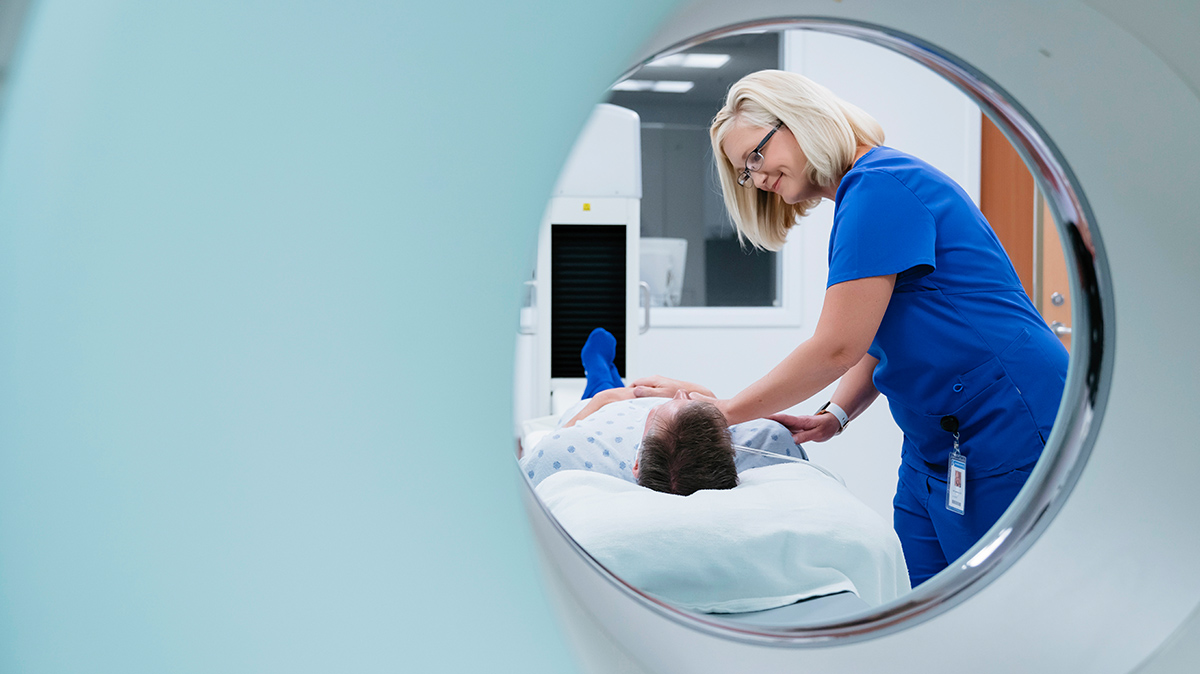Interventional Radiology

Leaders in Interventional Radiology
The Stanford Health Care Tri-Valley Interventional Radiology Program delivers innovative care personalized to your needs. We use state-of-the-art imaging technology and minimally invasive techniques for precise care with a faster recovery.
What We Offer You for Interventional Radiology
- Specialized expertise Specialized expertise using minimally invasive procedures to treat conditions including cancer, prostate disease, uterine fibroids, varicose veins, and peripheral artery disease.
- Advanced procedure options that typically use smaller incisions, have a lower risk of complications, and require less recovery time than traditional surgery.
- Team-based approach from highly skilled experts who partner with specialists across departments, including cardiology, oncology, and urology.
- Convenient, close-to-home care, with access to leading Stanford specialists right in your community.
At Stanford Health Care Tri-Valley, we use real-time images from computed tomography (CT) scans, ultrasound, X-rays, and fluoroscopy. Using these images and minimally invasive tools, we can perform procedures with only small incisions.
Image-guided technology allows us to see blood vessels, organs, and tumors in detail, so that we can simultaneously diagnosis and treat conditions with exceptional precision. These minimally invasive procedures require less recovery time and have a lower risk of complications.
We perform interventional procedures to safely diagnose and treat several conditions, including:
Our board-certified interventional radiologists perform minimally invasive, image-guided procedures to diagnose and treat a wide range of conditions.
Our interventional radiologists specialize in leading-edge procedures to treat cancer. These targeted treatments destroy tumors while preserving healthy tissue.
We offer interventional cancer care for:
- Kidney (renal) cancer
- Liver cancer
- Lung cancer
Instead of lengthy surgeries that demand long recoveries, our interventional radiologists perform minimally invasive procedures to manage liver disease complications. Interventional care may treat:
- Fibrosis: Formation of scar tissue in the liver that may be curable and reversible if found in time
- Cirrhosis: Severe scarring that replaces healthy tissue, preventing the liver from working properly
Our team uses nonsurgical techniques to treat PAD. This circulation disorder may involve blocked blood flow in the arteries, veins, or lymphatic vessels in the legs and feet.
Left untreated, PAD causes pain and numbness and can result in tissue death. Interventional care can restore blood flow and help you maintain your mobility.
Renovascular hypertension is high blood pressure caused by narrowing arteries that carry blood to your kidneys. When medications don’t work, our experts perform minimally invasive techniques to help control your blood pressure.
Working closely with our cardiovascular department, our interventional radiologists treat vascular malformations, including:
- Arteriovenous malformations: Abnormal connections between arteries and veins, usually in the brain or spine, that disrupt normal blood flow and oxygen circulation
- Congenital vascular malformations: From simple birthmarks to complex growths made up of arteries, veins, lymph vessels, or a combination of these
- Hereditary hemorrhagic telangiectasia (HHT): A genetic disorder that leads to abnormal blood vessels, typically in the lungs, brain, or liver
Venous problems affect the veins, blood vessels that return blood to your heart. Stanford Health Care Tri-Valley’s interventional radiologists skillfully treat:
- Deep vein thrombosis (DVT): A blood clot that develops in a vein deep inside the body, especially in the legs or pelvis
- Pulmonary embolism: A blood clot that develops in one part of the body and travels to an artery in the lung, forming a blockage
- Varicocele: Swollen veins in the scrotum that can cause pain, shrinking of the testicle, or fertility issues
- Varicose veins: Swollen, painful blood vessels in the legs
We blend our compassionate approach with additional training in using image-guided procedures to diagnose and treat:
- Uterine fibroids: Growths inside the uterus that can cause painful cramps and heavy periods
- Fallopian tube blockages: Blocked fallopian tubes, commonly caused by pelvic inflammatory disease, that can trigger infertility
- Pelvic congestion syndrome (PCS): Varicose veins that develop around the ovaries and can be very painful
Through our partnership with Stanford Health Care, we are one of the only programs to treat an enlarged prostate with an innovative minimally invasive technique. Prostatic artery embolization (PAE) reduces the size of the prostate by blocking certain blood vessels to the prostate. The procedure requires only a small puncture, with no incision.
PAE improves BPH symptoms such as:
- Slow urinary flow
- Difficulty urinating
- Frequent nighttime urination
Treatments
At Stanford Health Care Tri-Valley, you have access to the latest minimally invasive techniques for a range of medical conditions that previously required open surgery. Today, many of these procedures only require a small incision in the wrist, groin, or neck.
Our interventional radiologists have successfully performed hundreds of image-guided procedures, providing you with a safer experience and healthier outcomes. We offer:
- Biopsy: Uses a hollow needle to remove cells or tissue to identify disease
- Chemoembolization: For liver cancer, injects chemotherapy drugs via cather into the tumor when surgery or radiofrequency ablation (RFA) hasn’t helped
- Radioembolization: Injects radioactive beads via a cather into a tumor, typically in the liver
- Tumor ablation therapies: Burn or freeze tumors using different therapies, including radiofrequency ablation and cryoablation
- Acute DVT treatment: Removes or dissolves a blood clot using different devices that separate the clot into tiny pieces and remove them, relieving pain and swelling
- Chronic DVT treatment: Places metal stents (tiny mesh tubes) inside blocked veins to reopen them and restore blood flow
- Pulmonary embolism treatment: Inserts a filter into the inferior vena cava (IVC) to prevent blood clots from reaching the lungs
- Removal and dissolving of blood clots using different techniques.
- Angioplasty: Opens blocked arteries in different parts of the body by inserting a catheter into the artery and inflating a balloon to improve blood flow
- Aortic and atrial endovascular repair: Places a stent graft inside the aorta (the largest artery leaving the heart) to restore blood flow and prevent the aneurysm from bursting
- Renal hypertension treatment: Restores blood flow to arteries in the kidneys by inflating a balloon inside a blood vessel or inserting a permanent stent
- Prostatic artery embolization: Blocks blood vessels to the prostate to reduce its size and improve symptoms of benign prostatic hyperplasia (enlarged prostate)
- Gastrostomy (feeding) tube: Inserts a feeding tube into the stomach to provide nutrition when you can’t consume nutrients by mouth
- Hemodialysis: Places catheters and ports to ensure direct, safe access to hemodialysis
- Long-term venous access catheter: Inserts different types of catheters that create a simple, pain-free way for providers to draw blood or give nutrients or medicine
- Sclerotherapy: Injects special medicines into unsightly veins to harden them so veins shrink or disappear
- Radiofrequency treatment: Applies heat to close off varicose veins
- Varicocele treatment: Closes or ties off the vein in the scrotum to reduce pressure
- Vascular malformation treatment: Uses techniques such as embolization to block the blood vessel and sclerotherapy to harden the vein
- Fallopian tube recanalization: Reopens blocked fallopian tubes using a small catheter
- Pelvic congestion treatment: Blocks varicose veins that develop around the ovaries to treat pelvic pain
- Uterine fibroid embolization (UFE): Cuts off the blood supply to uterine fibroids to shrink them
- MRI-guided focused ultrasound surgery: Pinpoints the precise location of a uterine fibroid and uses sound waves to heat and destroy it
Your Interventional Radiology Care Team
Our board-certified interventional radiologists work closely with specialists in other departments, including cancer, cardiology, gynecology, radiology, and urology. We partner with you and your care team to offer precise treatments and comprehensive care.

Your Doctors
Interventional Radiologists
These doctors have advanced training in using imaging technology to help guide minimally invasive diagnostic and treatment procedures.
View All Interventional Radiologists
Support Services
We help with the details so you can focus on your health and wellness. We offer a range of patient services and helpful information to coordinate the various aspects of your care:
At Stanford Health Care Tri-Valley, our interventional radiology team is dedicated to delivering attentive, accessible care. We make it easy for you to schedule an appointment, learn more about your procedure, and contact a member of your care team.
Convenient care where you live and work
- Insurance and billing: We accept several insurance plans to serve you. Please check with your plan to confirm coverage. Find out more about patient financial services at Stanford Health Care Tri-Valley.
- MyHealth: Our MyHealth system allows you to access your records and test results through a secure, online portal and device app. You can also communicate with your doctors.
